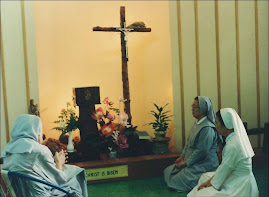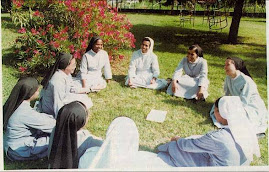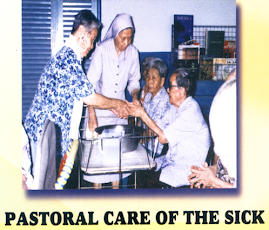SINGAPORE Canossians walk with the times, respond to needs of people
February 2, 2009
SINGAPORE (UCAN) --
A Canossian sister ministering to the elderly finds joy in little things, such as residents' eyes growing brighter and their confidence to do things again returning.
Singaporean Sister Mary Tan, 73, celebrates her 50th anniversary as a Canossian this year.
As Sister Mary Tan makes her daily rounds at Villa Francis Home for the Aged, the residents greet her with wide smiles. "We do little things for them to make their lives more comfortable," she explained. Coming to a man with a toothy smile, she caressed his hair and said, "We cut his hair short, as he said he felt very hot."
She summarizes her pastoral care apostolate to the elderly in a simple phrase -- "to give them a quality life."
"I see improvement in the people. Some, when they first came, their eyes were closed, but now their eyes are [opened] bigger, and the wheelchair-bound [stroke victims] slowly regain their confidence in physiotherapy and learn to walk again," she said.
Sister Tan is one of three local Canossians celebrating 50 years as nuns this year. Their congregation has been running Villa Francis Home for the Aged since 2006. The home was started in 1978 by the Franciscan Missionaries of the Divine Motherhood, who withdrew from running the home in 2001, after which it was run by a lay administrator until the Canossians were asked to take over.
The Canossians' ministry to the sick and elderly goes back to 1968, however, when Catholic Welfare Services asked them to run a mobile clinic. Sister Tan and a volunteer doctor began that service.
"We wanted to serve all races, but there was a difficulty entering Jalan Eunos, where the Malays lived," she recalled, because they feared the nuns would try to convert them." Malays account for the majority of Muslims in Singapore, a member of the Federation of Malaysia until it became independent in 1965.
Rather than force the issue, Sister Tan suggested that the mobile clinic visit Changi Village, on the east end of the island-state, as she was familiar with the Malay community there.
"Fifty of them came on the first day, because the government clinics then gave very diluted cough syrup, about half of which was water, whereas our medicine came from America and was more concentrated and effective," she narrated.
The mobile clinic eventually served three communities in three locations: the ethnic Chinese population in Tuas, the ethnic Indian population in Jalan Kayu, and the Malays in Changi.
In 1978, Sister Tan took helped start St. Joseph's Home, which Catholic Welfare Services set up that year "to provide shelter, care and love for the aged and destitute, regardless of race or religion," according to the home's website.
Less than 10 years later, in 1985, the Canossian Sisters started Singapore's first facility for the terminally ill, a ward inside St. Joseph's Home. "We couldn't call it a hospice, because the government did not allow it. They feared a repeat of the Sago Lane 'death houses,'" Sister Tan explained.
Sago Lane is a street in the Chinatown section where terminally ill people without relatives were left to die in so-called "death houses," usually without proper food or medicine. The government banned these in 1961.
The Canossians' work for the terminally ill paved the way for the training of volunteers and nurses in hospice care, and the establishment of proper hospices. Today, eight hospice care providers operate in Singapore.
Despite being the largest religious order in Singapore, the 54 Canossian sisters here, 48 of whom are native Singaporeans, are becoming "an endangered species," says Sister Marilyn Lim, who became head of their province in December 2008.
Sister Jessica Teo, the province's vocation animator, explained that the last sister to profess perpetual vows did so in 2006, and they had no postulants from then until one joined the community this year.
The sisters used to work mostly in Canossian schools, "but at one point, they realized that their role had become so administrative that they were losing that personal touch with students," Sister Lim pointed out.
In order to be faithful to the spirit of Saint Magdalene of Canossa, their foundress, the Canossians opted for early retirement to create a strong chaplaincy team in the schools, the provincial superior continued. They converted their apostolate to one that focused more on pastoral care, she said, following their foundress's advice to "walk with the times."
END
Source:
http://www.ucanews.com/2009/02/02/canossians-walk-with-the-times-respond-to-needs-of-people/
Monday, 9 March 2009
Subscribe to:
Post Comments (Atom)












No comments:
Post a Comment